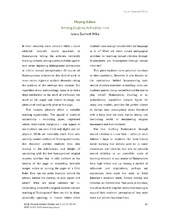| dc.contributor.author | Miles, Laura Saetveit | |
| dc.date.accessioned | 2016-07-04T13:24:17Z | |
| dc.date.available | 2016-07-04T13:24:17Z | |
| dc.date.issued | 2015 | |
| dc.Published | Early Modern Culture Online 2015, 6:41-47 | eng |
| dc.identifier.issn | 1892-0888 | |
| dc.identifier.uri | https://hdl.handle.net/1956/12242 | |
| dc.description.abstract | This commentary feature considers the advantages of using textual criticism to teach Shakespeare and using Shakespeare to teach textual criticism, at both the undergraduate and graduate level. First I discuss how to do this in practical terms, by suggesting some specific, concrete activities that bring an editorial approach into the classroom: interactive ‘editorial exercises’ that involve micro to macro textual problems. Then I discuss what is to be gained by teaching textual criticism through Shakespeare. Students can be profoundly transformed into critical thinkers and critical readers in four ways: 1) Healthy skepticism: i.e. undermining trust in editions, editors—and authority; 2) Healthy optimism: i.e. building a feeling of critical community; 3) Defamiliarizing the text and unsettling reading practices; 4) Combining a relish for puzzles, clues, data, detective work with the love of reading. In general this piece aims to be both a practical and philosophical consideration of the intersection of editing, Shakespeare, and teaching. | en_US |
| dc.language.iso | eng | eng |
| dc.publisher | Early Modern Research Group and The Bergen Shakespeare and Drama Network | eng |
| dc.rights | This work is licensed under a Creative Commons Attribution 3.0 License. | eng |
| dc.rights.uri | https://creativecommons.org/licenses/by/3.0/ | eng |
| dc.title | Playing Editor: Inviting Students Behind the Text | eng |
| dc.type | Peer reviewed | |
| dc.type | Journal article | |
| dc.date.updated | 2016-04-11T06:02:12Z | |
| dc.description.version | publishedVersion | |
| dc.identifier.cristin | 1332032 | |
| dc.subject.nsi | VDP::Humaniora: 000::Litteraturvitenskapelige fag: 040::Engelsk litteratur: 043 | |

